Polishing pad and preparation method thereof
A polishing pad and polishing layer technology, applied in grinding/polishing equipment, manufacturing tools, metal processing equipment, etc., can solve the problems of low grinding efficiency, high processing needs, low efficiency, etc., and achieve fast solvent exchange speed and water washing time. Short, productive results
- Summary
- Abstract
- Description
- Claims
- Application Information
AI Technical Summary
Problems solved by technology
Method used
Image
Examples
preparation example Construction
[0046] A preparation method of a polishing pad, comprising the following steps:
[0047] 1) Prepare the base material; take the preset base material, place it in the water-based glue for roll impregnation; then, remove the excess water-based glue on the surface of the base material, and dry it to obtain a spare base material;
[0048] 2) Substrate pre-treatment: coating the second surfactant on the back of the spare substrate, then drying with a hot roller, and ironing to obtain a molding substrate;
[0049] 3) preparing a polishing layer; configuring a polishing layer composite material, and then coating the polishing layer composite material on the upper surface of the molding substrate; then sequentially performing coagulation bath, washing and drying to obtain a semi-finished product;
[0050] 4) post-treatment: surface treatment is carried out on the semi-finished product.
Embodiment 1
[0052] A polishing pad is prepared according to the following steps:
[0053] 1) The preparation of the polishing pad substrate; the thickness is 2.5mm, and the unit thickness weight (1mm) is 160g / (m 2 .mm) of non-woven fabric, after being impregnated with acrylic water-based latex with a solid content of 8.0% and rolled, the excess liquid on the surface was scraped off, and dried at high temperature. Then use a slicer to divide the impregnated non-woven fabric into two pieces with the same thickness from the thickness direction, and finally polish the two surfaces of the impregnated non-woven fabric with a grinder, wind up and make two pieces with a thickness of 1.1mm and polish The base material of the pad.
[0054] 2) Substrate treatment before coating: sorbitan tristearate (Span 65) with an HLB value of 2.1 was dispersed in acetone with high-speed stirring to form a Span 65-acetone dispersion emulsion with a concentration of 10.0%. Then, use a high-pressure spray gun to ...
Embodiment 2
[0059]A polishing pad is prepared according to the following steps:
[0060] 1) The preparation of the polishing pad substrate; the thickness is 1.4mm, and the unit thickness weight (1mm) is 180g / (m 2 .mm) of non-woven fabrics, after dipping and rolling with polyurethane water-based latex with a solid content of 9.0%, scrape off excess liquid on the surface, and dry at high temperature. Then use a slicer to divide the impregnated non-woven fabric into two pieces with the same thickness from the thickness direction, and finally use a grinder to polish the two surfaces of the impregnated non-woven fabric, wind up two pieces with a thickness of 0.6mm and polish The base material of the pad.
[0061] 2) Substrate treatment before coating: sorbitan monooleate (Span 80) with an HLB value of 4.3 was dissolved in ethanol with high-speed stirring to form a Span 80-ethanol solution with a concentration of 15.0%. Then, use a high-pressure spray gun to spray on the polished surface of t...
PUM
| Property | Measurement | Unit |
|---|---|---|
| thickness | aaaaa | aaaaa |
| diameter | aaaaa | aaaaa |
| thickness | aaaaa | aaaaa |
Abstract
Description
Claims
Application Information
 Login to View More
Login to View More - R&D
- Intellectual Property
- Life Sciences
- Materials
- Tech Scout
- Unparalleled Data Quality
- Higher Quality Content
- 60% Fewer Hallucinations
Browse by: Latest US Patents, China's latest patents, Technical Efficacy Thesaurus, Application Domain, Technology Topic, Popular Technical Reports.
© 2025 PatSnap. All rights reserved.Legal|Privacy policy|Modern Slavery Act Transparency Statement|Sitemap|About US| Contact US: help@patsnap.com



